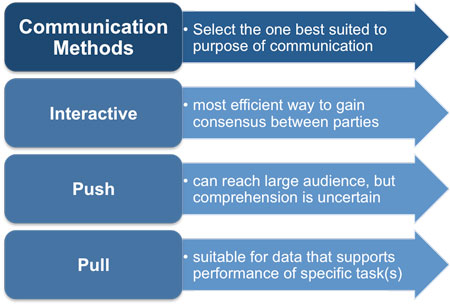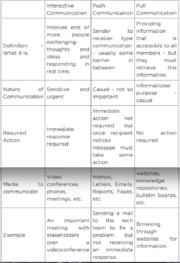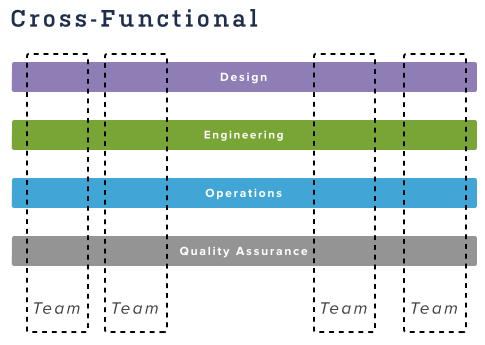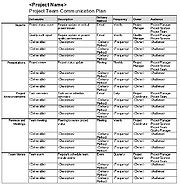Effective Communication in Project Management
| Line 123: | Line 123: | ||
Mapping Cancer Markers aims to improve and personalize cancer treatment. The project has three goals: first, to identify markers that can be used to detect cancer earlier; second, to identify high-risk cancer patients; and third, to find markers that can predict treatment response. | Mapping Cancer Markers aims to improve and personalize cancer treatment. The project has three goals: first, to identify markers that can be used to detect cancer earlier; second, to identify high-risk cancer patients; and third, to find markers that can predict treatment response. | ||
| − | Mapping Cancer Markers will also enable researchers to develop even more efficient and effective computational methods for discovering relevant patterns of markers. This could help make the use of markers in personalized medicine more practical and more broadly applicable to other cancers and other complex diseases. | + | Mapping Cancer Markers will also enable researchers to develop even more efficient and effective computational methods for discovering relevant patterns of markers. This could help make the use of markers in personalized medicine more practical and more broadly applicable to other cancers and other complex diseases.[9] |
| Line 147: | Line 147: | ||
[8]Laughlin, P. R. Ability and group problem solving. Ptiurnuf of Research and Developmenr in Educalion it:li4-120 (1978). | [8]Laughlin, P. R. Ability and group problem solving. Ptiurnuf of Research and Developmenr in Educalion it:li4-120 (1978). | ||
| + | |||
| + | [9]World Community Grid; Help Defeat Cancer: Project Overview; IBM; http://www.worldcommunitygrid.org/research/hdc/overview.do | ||
| + | https://secure.worldcommunitygrid.org/research/mcm1/details.do | ||
Revision as of 18:17, 27 September 2015
The word communication will be used here in a very broad sense to include all of the procedures by which one mind may affect another. This, of course involves not only written and oral speech, but also music, pictorial arts, the theatre, the ballet and in fact all human behaviour. In some connections it may be desirable to use a still broader definition of communication, namely, one which would include the procedures by means of which one mechanism (say automatic equipment to track an airplane and to compute its probable future positions) affects another mechanism (say a guided missile chasing this airplane).
Warren W. Weaver [1]
Contents |
Abstract
Methods of Communication
Visual Communication
Visual communication is one of the methods used to communicate information or expression of ideas through a visual form. Information could be communicated also by draw, pictures, charts or graphs.
One example of visual communication is represented through a great tool that is utilized by many different project management, agile and even Six Sigma disciplines is the Ishikawa or fishbone diagram. An Ishikawa diagram is used to ensure that a balanced list of ideas is generated during brainstorming or that major possible causes were not overlooked. Given its simplicity, it is easy to see why it has gained acceptance across so many disciplines. It also only takes a pen and paper (or whiteboard and marker) to get started, and it can be used during any phase of a project. Brainstorming, root-cause analysis, documenting a process flow’s inputs/outputs and the possible scenarios where it can be used makes this an indispensable tool for all team members. It should be used on a regular basis when communicating ideas or issues and is a prime example of the power of visual communication.
These techniques aim to get at the root causes of a problem and not just the symptoms. Kaoru Ishikawa,a Japanese Quality pioneer, introduced a very visual ‘Fishbone’ diagram that helps a whole team focus on this and get rapidly to consensus. This diagram:
•Resembles the skeleton of a fish
•Focus on causes rather than symptoms of a problem
•Emphasizes group communication and brainstorming
•Stimulates discussion
The first step is to get clarity and consensus on what the problem is to get a focused problem statement. A problem might be stated originally as ‘customers complain of poor service. After discussion, this might be refined to ‘Poor resolution of technical queries on evenings and weekends’. This tighter statement helps focus the task of getting to the root cause of the problem. This problem statement is put at the ‘head’ of the fish, along with the fish’s backbone:
The next step is to brainstorm potential causes of the problem. This may be augmented by prior research by the team, using metrics and statistical analysis if appropriate. The major types of cause are then laid out as large bones connected to the backbone. Either of two alternative approaches should be used:
•Categories of causes:
oFor a production/manufacturing process, these usually are People, Materials, Machinery/Equipment, Methods, Environment and Measurement.
oFor a service process, they are often People, Policies, Procedures (the flow of the process), Location (Equipment/Space) and Measurement.
•Process steps: the major process steps are used.
The key is to be flexible and use the category type and categories themselves most appropriate to the problem in hand, based on the causes surfaced from the brainstorm. [2]
Effective Communication
Figure 2: Different methods of effective communication.
The project manager decides, based on communication requirements, what, how, and when communication methods are to be used in the project. This process requires discussion and dialogue with the project team to determine the most appropriate way to update and communicate project information, and to respond to requests from various stakeholders for that information.
[2]
Interactive Communication
Interactive communication is an exchange of ideas where both participants, whether human, machine or art form, are active and can have an effect on one another. It is a dynamic, two-way flow of information.[3] Many forms of communication previously thought one-way, like books and television, have become interactive with the rise of computers, the Internet, and digital and mobile devices. These developing collaborative technologies, or new media, have rapidly increased the opportunities for interactive communication across mediums, disciplines, cultures, social classes, locations, and even time.
Interactive communication is a modern term that encompasses these evolving forms of conversation. It is a primary characteristic of the present Information Age. New experiments in interaction design are evolving on a daily basis.
Interactive communication forms include basic dialogue and nonverbal communication, gamebooks, interactive fiction and storytelling, hypertext, interactive television and movies, photo and video manipulation, video sharing, video games, social media, user-generated content, interactive marketing and public relations, augmented reality, ambient intelligence, and virtual reality.
An interactive communication is required when the communication is likely to be misinterpreted. Every stakeholder can respond to each other in real time
Push Communication
This type of communication is used from sender to receiver. It is preferable when the sender sends information and do not want an immediate response from receiver or when the information do not need immediate response because is not pressing or as important. Examples of Push Communication are : emails, letter, reports or faxes. It is not a face-to-face communication but always an information through a written medium.
Take, for example, you have a technical issue that demands immediate attention, and you alert the Tech department of your company to fix it. You send the Tech guy a mail. He isn't available for the day and is therefore not able to receive and attend to your mail. You only know that the mail you wrote has been successfully sent. You do not know if he has received it or not. You will only know that he has when he comes and fixes our problem that will be the next day. [4]
Pull Communication
This type of communication is used from sender to a large audience. All members that want to have information can access to in through a common way. Example of Pull Communication are post on websites, Podcasts, blogs, exc. The reicever has to recover this information.
A sample-case scenario would be when you have enrolled for a project management course and need access to more inputs on your course, and you begin to search for relevant information from the Articles/Ebooks that is available on the training provider’s site itself.[5]
Communication in Project Management
Communication is one of the most important part of project management. Working on a project there must be a good communication between who is planning the work and who is working on it. A successful project manager must be a great communicator. Doing the same things with the same people in the same place is never possible because the projects are always different, and for these reasons every project needs the best way to communicate between manager and workers. As a result, employing effective communication methods are necessary to ensure project success.
The lack of communication has been specifically linked to problems in new development and project failures. Communication is the vehicle through which personnel from multiple functional areas share information that is so critical to the successful implementation of projects. Making decisions, managers must both acquire and disseminate information in order to serve a number of distinct purposes, all related to improving the interactions among members of the project team and to the ultimate successful implementation of the project. One of the reason that lead project team members to communicate is to brainstorm about ideas , to resolve implementation problems, for example, scheduling changes, and to review the progress of the project.
Communication and Cross-Functional Cooperation within a Project Team
Figure 4: Cross Functional team project
In this article are reported some methods of communication but to understand how and why communication is important within the projects, the following research it is exposed; Specifically, this research examined a behavioral variable: project team communication and its relationship to cross-functional cooperation.
The need for cross-functional cooperation stems from the complex functional interdepen- dencies within organizations. Organizations consist of several interrelated functional units. In attempting to develop and implement new programs, one functional area may not have direct authority over other departments. Cooperation is necessary to link interdependent functions together and assure their contribution to the overall goals of the organization, As Thompson [7] suggested, greater interdependence requires a greater cooperation effort. Problems associated with cross-functional cooperation result from not only the interdependence of work process and technology, but from conflicts over authority and jurisdiction among different units. Cross-functional cooperation is important in the implementation of marketing decisions because cooperation has been shown to promote productivity by helping individuals perform more effectively.Laughlin [8] argues that people in cooperation tend to understand and be influenced by each others’ interest and ideas, seek and give information, communicate about tasks, more readily assist each other and rely on division of labor.
Psychosocial outcomes refer to how individuals involved in an implementation effort “feel” about the implementation process. To date, psychosocial outcomes have not been adequately addressed to determine their impact on successful project implementation. The psychosocial outcomes generated from a completed project can have a powerful impact on the attitudes and activities of project team members in future projects. If the process was enjoyable and devoid of interpersonal and technical problems, it is likely that team members will approach future projects with a more positive frame of mind, as compared to instances in which they were involved in projects fraught with dimculties. In this research, successful implementation of new programs is assessed by two components: task outcomes and psychosocial outcomes. Task outcomes refer to factors involved in the actual implementation of the project (time, schedule and performance) and its subsequent usage or performance. Psychosocial outcomes refer to whether or not the implementation process was considered to be worthwhile, satisfying and productive. This discussion yielded the final hypotheses of the study. H3a: The greater the degree of cross-functional cooperation achieved among project team members, the higher the evaluation of task outcomes. H3b: The greater the degree of cross-functional cooperation achieved among project team mem-bers, the higher the evaluation of psychosocial outcomes. [6]
Example of Push Communication in a real life case
World Community Grid; Fighting against Cancer
Currently, the primary methods used to evaluate tissue microarrays involve manual, interactive review of samples during which they are subjectively evaluated and scored. An alternate, but less utilized strategy is to sequentially digitize specimens for subsequent semi-quantitative assessment. Both procedures ultimately involve the interactive evaluation of TMA samples, which is a slow, tedious process that is prone to human error. Much of the difficulty in rendering consistent evaluation of expression patterns in cancer tissue microarrays is due to subjective impressions of observers.
IBM's World Community Grid will enable the most computationally expensive components of the software to run at optimal speed, thereby increasing the accuracy and sensitivity with which expression calculations and pattern recognition procedures can be conducted. By harnessing the collective computational power of World Community Grid, researchers will be able to analyze a larger set of cancer tissue specimens and conduct experiments using a much broader ensemble of biomarkers and stains than is possible using traditional computer resources.
To date, only a fraction of the known biomarkers have been examined. The long-term goal is to create a library of biomarkers and their expression patterns so that, in the future, physicians can consult the library to help them in rendering diagnoses and providing the most effective treatment for patients with cancer.
In the absence of World Community Grid, TMA's are processed in individual or small batches. Using World Community Grid, analysis can be carried out for hundreds of arrays in parallel, allowing multiple experiments to be conducted simultaneously. This added level of speed and sophistication could potentially enable investigators to detect and track subtle changes in measurable parameters, thereby facilitating discovery of prognostic clues, which are not apparent by human inspection or traditional analysis alone and could advance the fields of cancer biology, drug discovery and therapy planning.
Mapping Cancer Markers aims to improve and personalize cancer treatment. The project has three goals: first, to identify markers that can be used to detect cancer earlier; second, to identify high-risk cancer patients; and third, to find markers that can predict treatment response.
Mapping Cancer Markers will also enable researchers to develop even more efficient and effective computational methods for discovering relevant patterns of markers. This could help make the use of markers in personalized medicine more practical and more broadly applicable to other cancers and other complex diseases.[9]
Limitations
Conclusion
References
[1]Weaver, Warren: Recent Contributions to the Mathematical Theory of Communication (1949) , http://www.panarchy.org/weaver/communication.html
[2]Cause and Effect Analysis using the Ishikawa Fishbone; © City Process Management 2008 Web: http://www.cityprocessmanagement.com
[3]https://en.wikipedia.org/wiki/Interactive_communication
[4]http://www.free-management-ebooks.com/faqpm/team-07.htm
[5]http://www.simplilearn.com/interactive-vs-push-vs-pull-communication-in-project-management-article
[6]Pinto, Mary Beth ; Pinto, Jeffrey K. : Project Team Communication and Cross-Functional Cooperation in new Program Development; Journal of Product Innovation Management- 1990, Volume 7, Issue 3, pp.200-212
[7]Thompson, J. D. Organizations in Action. New York: McGraw- Hill, 1967
[8]Laughlin, P. R. Ability and group problem solving. Ptiurnuf of Research and Developmenr in Educalion it:li4-120 (1978).
[9]World Community Grid; Help Defeat Cancer: Project Overview; IBM; http://www.worldcommunitygrid.org/research/hdc/overview.do https://secure.worldcommunitygrid.org/research/mcm1/details.do




